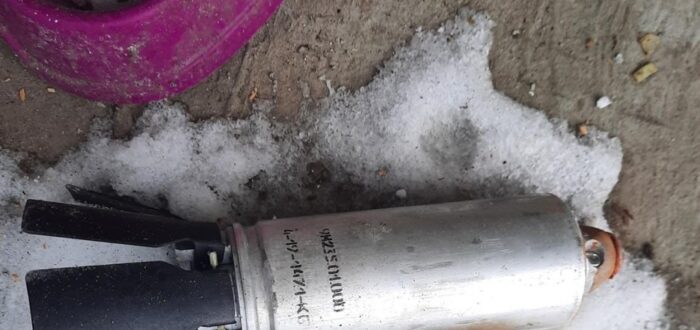N.R. Jenzen-Jones & Patrick Senft
Editor’s Note: This article is based primarily on previous ARES articles documenting the use of the N235 submunition in Syria and Ukraine in 2014.
Numerous photos posted on Twitter by the State Emergency Service of Ukraine (DSNS), Kharkiv Region, and others show munitions marked in Cyrillic “9H235” (‘9N235’) that have been employed by Russian forces in Ukraine. These markings identify the munitions as Russian 9N235 submunitions, indicate that the submunitions used in this attack were manufactured in 2019, and provide additional lot/batch information that may be helpful in future analysis.
The 9N235 submunition is a high explosive fragmentation (HE-FRAG) submunition designed to engage both personnel and unarmored vehicles in open terrain or behind light cover. The body of the 9N235 is cylindrical in form, measuring 263 mm in length and 65 mm in diameter. Each 9N235 features six spring-loaded fins, which open after separation from the carrier munition to orient the submunition such that its nose—fitted with the 9E272 impact fuze—strikes the ground first. The 9E272 impact fuze is paired with a self-destruct mechanism that is designed to function 110 seconds after ejection from the cargo rocket. 9N235 submunitions contain 312 g of what is believed to be A-IX-10 explosive composition, consisting of 95% RDX phlegmatised by the addition of 5% paraffin wax. The submunition contains pre-formed fragmentation consisting of pieces of chopped steel rods. These are of two sizes: the smaller fragments (nominally weighing 0.75 g) are mainly intended to injure and kill personnel, whereas the larger fragments (nominally 4.5 g) are intended to damage lightly armoured vehicles and materiel. Each 9N235 contains approximately 96 4.5 g fragments and 360 0.75 g fragments.

From the available imagery described, it is unclear how the 9N235 submunitions were delivered in this particular incident. However, in the ongoing war in Ukraine, ARES has identified 9N235 submunitions delivered by both the 300 mm 9M55K and the 220 mm 9M27K1 cargo rockets. The 300 mm 9M55K cargo rocket is fired by the 9K58 Smerch (Смерч; ‘Tornado’) multiple-barrel rocket launcher (MBRL). The 9K58 MBRL system was initially designed in the USSR and its unguided rockets can be readily identified by their distinctive nose cones and tail fins, and by an analysis of internal frame and separation components. When carrying 9N235 fragmentation submunitions, the 9M55K rocket has a range of 20 to 70 km and can deliver 72 submunitions. The rocket weighs 800 kg (the warhead accounting for 243 kg of this) and measures 7,600 mm in length (the warhead section being 2,049 mm long). The 220 mm 9M27K1 cargo rocket for the 9K57 Uragan (Ураган; ‘Hurricane’) MLRS is also capable of carrying the 9N235 submunition. When the cargo rocket carries 9N210 fragmentation submunitions (physically nearly identical to the 9N235), it has a range of between 10 to 35 km and can deliver 30 submunitions. The rocket weighs 270 kg (90 kg of which is the warhead) and measures 5,178 mm in length. The 9M55K and 9M27K cargo rockets are depicted in Figure 2.

The 9N235 submunition is, outwardly, nearly physically identical to the 9N210. The two can be positively differentiated by examining the markings on the submunition’s body (see Figure 1), however. Internally, the 9N210 differs from the 9N235 in that it contains only a single size of pre-formed fragments. The 9N210 submunition contains between 370 and 400 fragments formed from chopped steel rod, each weighing a nominal 2.0 g each. In addition, both the 9N235 and 9N210 feature a self-destruct mechanism, but the delay time is different—60 seconds for the 9N210 and 110 seconds for the 9N235. Note that several observers and commentators have erroneously claimed that the 9N210 is exclusively used with the 9M27K (Uragan) rocket, whereas the 9N235 can only be deployed from the 9M55K (Smerch) rocket. ARES has previously documented both submunitions deployed from both types of cargo rockets in Ukraine, Syria, and elsewhere. The 9N235 submunition is also carried by the 300 mm 9M525 cargo rocket.
Technical Characteristics
9M55K cargo rocket (with 9N235 submunitions)
Range: 20–70 km
Weight: 800 kg
Length: 7,600 mm
Warhead weight: 243 kg
Warhead length: 2,049 mm
Payload: 72 × 9N235 submunitions
9M27K cargo rocket (with 9N210 submunitions)
Range: 10–35 km
Weight: 270 kg
Length: 5,178 mm
Warhead weight: 90 kg
Payload: 30 × 9N210 submunitions
9N235 submunition
Length: 263 mm
Diameter: 65 mm
Weight: 1.75 kg
Explosive weight: 312 g
Explosive composition: A-IX-10
Number of pre-formed fragments: 96 × 4.5 g; 360 × 0.75 g
Fuze: 9E272 (impact)
Sources
ARES (Armament Research Services). n.d. Conflict Materiel (CONMAT) Database. Confidential. Perth: ARES.
Jenzen-Jones, N.R. 2014a. ‘9M55K cargo rockets and 9N235 submunitions in Ukraine’. The Hoplite. 3 July. <http://armamentresearch.com/9m55k-cargo-rockets-and-9n235-submunitions-in-ukraine/>.
Jenzen-Jones, N.R. 2014b. ‘9M27K series cargo rockets used in Ukraine’. The Hoplite. 11 July. <http://armamentresearch.com/9m27k-series-cargo-rockets-used-in-ukraine/>.
Jenzen-Jones, N.R. & Yuri Lyamin. 2014a. ‘9M55K Cargo Rockets and 9N235 Submunitions in Syria’. The Hoplite. 16 February. <http://armamentresearch.com/9m55k-cargo-rockets-and-9n235-submunitions-in-syria/>.
Smalwood, Michael & Yuri Lyamin. 2014. ‘9M27K Series Cargo Rockets in Syria.’ The Hoplite. 22 February. <http://armamentresearch.com/9m27k-series-cargo-rockets-in-syria/>
Human Rights Watch, 2022. ‘Ukraine: Cluster Munitions Launched Into Kharkiv Neighborhoods’. 4 March. Available via: <https://reliefweb.int/sites/reliefweb.int/files/resources/Ukraine_%20Cluster%20Munitions%20Launched%20Into%20Kharkiv%20Neighborhoods.pdf>.
Remember, all arms and munitions are dangerous. Treat all firearms as if they are loaded, and all munitions as if they are live, until you have personally confirmed otherwise. If you do not have specialist knowledge, never assume that arms or munitions are safe to handle until they have been inspected by a subject matter specialist. You should not approach, handle, move, operate, or modify arms and munitions unless explicitly trained to do so. If you encounter any unexploded ordnance (UXO) or explosive remnants of war (ERW), always remember the ‘ARMS’ acronym:
AVOID the area
RECORD all relevant information
MARK the area from a safe distance to warn others
SEEK assistance from the relevant authorities

